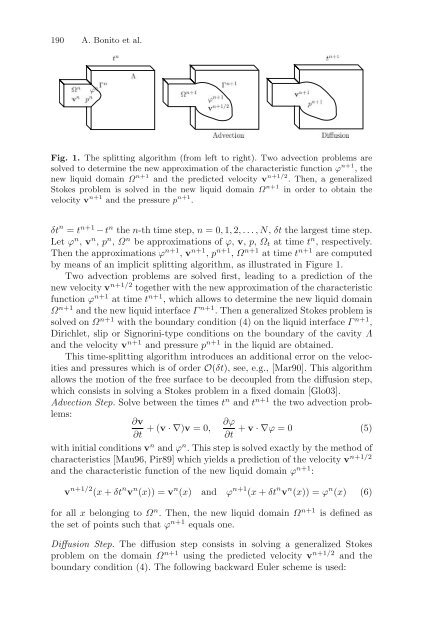Partial Differential Equations - Modelling and ... - ResearchGate
Partial Differential Equations - Modelling and ... - ResearchGate
Partial Differential Equations - Modelling and ... - ResearchGate
Create successful ePaper yourself
Turn your PDF publications into a flip-book with our unique Google optimized e-Paper software.
190 A. Bonito et al.<br />
Fig. 1. The splitting algorithm (from left to right). Two advection problems are<br />
solved to determine the new approximation of the characteristic function ϕ n+1 , the<br />
new liquid domain Ω n+1 <strong>and</strong> the predicted velocity v n+1/2 . Then, a generalized<br />
Stokes problem is solved in the new liquid domain Ω n+1 in order to obtain the<br />
velocity v n+1 <strong>and</strong> the pressure p n+1 .<br />
δt n = t n+1 − t n the n-th time step, n =0, 1, 2,...,N, δt the largest time step.<br />
Let ϕ n , v n , p n , Ω n be approximations of ϕ, v, p, Ω t at time t n , respectively.<br />
Then the approximations ϕ n+1 , v n+1 , p n+1 , Ω n+1 at time t n+1 are computed<br />
by means of an implicit splitting algorithm, as illustrated in Figure 1.<br />
Two advection problems are solved first, leading to a prediction of the<br />
new velocity v n+1/2 together with the new approximation of the characteristic<br />
function ϕ n+1 at time t n+1 , which allows to determine the new liquid domain<br />
Ω n+1 <strong>and</strong> the new liquid interface Γ n+1 . Then a generalized Stokes problem is<br />
solved on Ω n+1 with the boundary condition (4) on the liquid interface Γ n+1 ,<br />
Dirichlet, slip or Signorini-type conditions on the boundary of the cavity Λ<br />
<strong>and</strong> the velocity v n+1 <strong>and</strong> pressure p n+1 in the liquid are obtained.<br />
This time-splitting algorithm introduces an additional error on the velocities<br />
<strong>and</strong> pressures which is of order O(δt), see, e.g., [Mar90]. This algorithm<br />
allows the motion of the free surface to be decoupled from the diffusion step,<br />
which consists in solving a Stokes problem in a fixed domain [Glo03].<br />
Advection Step. Solve between the times t n <strong>and</strong> t n+1 the two advection problems:<br />
∂v<br />
∂ϕ<br />
+(v ·∇)v =0, + v ·∇ϕ =0 (5)<br />
∂t ∂t<br />
with initial conditions v n <strong>and</strong> ϕ n . This step is solved exactly by the method of<br />
characteristics [Mau96, Pir89] which yields a prediction of the velocity v n+1/2<br />
<strong>and</strong> the characteristic function of the new liquid domain ϕ n+1 :<br />
v n+1/2 (x + δt n v n (x)) = v n (x) <strong>and</strong> ϕ n+1 (x + δt n v n (x)) = ϕ n (x) (6)<br />
for all x belonging to Ω n . Then, the new liquid domain Ω n+1 is defined as<br />
the set of points such that ϕ n+1 equals one.<br />
Diffusion Step. The diffusion step consists in solving a generalized Stokes<br />
problem on the domain Ω n+1 using the predicted velocity v n+1/2 <strong>and</strong> the<br />
boundary condition (4). The following backward Euler scheme is used:
















